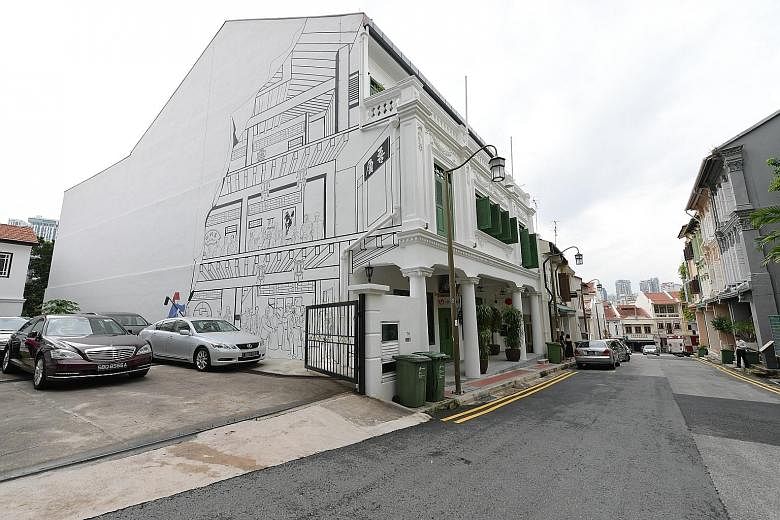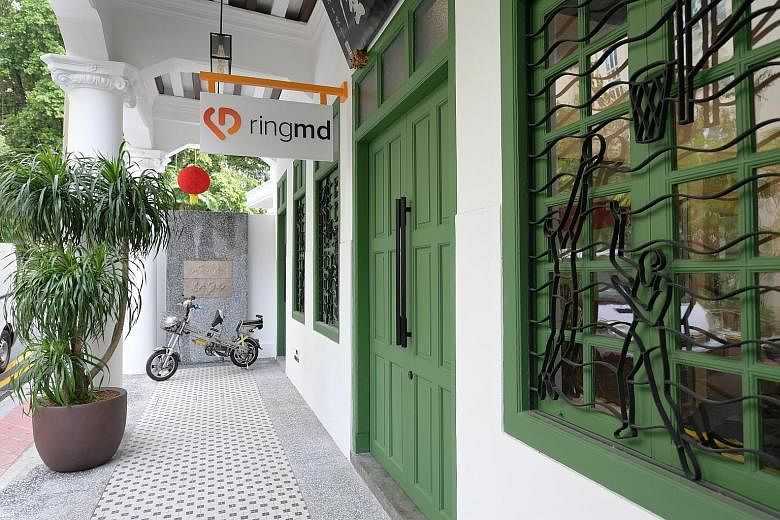For a decade, the 112-year-old Goh Loo Club at 72 Club Street, once a hotbed of activity, stood in disrepair among hip bars and restaurants.
In a bid to stay relevant and attract younger members, members who took over in 2012 decided to revitalise the club, which was formed as a gathering place for the local Chinese community.
Many of Singapore's founding fathers such as Dr Lim Boon Keng, who was also a writer, and prominent businessman and philanthropist Lee Kong Chian were members.
The club premises - a 998 sq m, three-storey shophouse that was gazetted for conservation in July 1989 - underwent a 16-month renovation. It was completed in April last year at a cost of $3.8 million.
The building's original timber louvre windows, interior brick walls and timber structures, joints and flooring were restored. The original interior colonial- style columns were also uncovered when timber panels concealing them were removed.
The club was among the winners of the Urban Redevelopment Authority's (URA) Architectural Heritage Awards last year, which recognise exceptional restoration works of national monuments and conserved buildings.
Mr Alex Tan, 71, a committee member of the club, says the renovation - helmed by architecture and interior design firm Artprentice and construction company Jinmac - injected freshness into the building again. "The old club was very tight in space and the ambience was rather claustrophobic."
The club - which was founded in 1905 and moved to its current premises in 1927 - got its name from a poem by famous Chinese poet Tao Yuanming, where the author waxes lyrical about his cottage. In Hokkien, "Goh Loo" means love cottage, says Mr Tan.
Much of the building's original elements were restored and retained as preserving its heritage was of utmost importance to the club. For instance, the original three-legged mahjong tables, which were used by past members, are still there.
But the club also had to ensure that the refurbished space would be suitable for modern use. The third floor, for example, was turned into an open-plan multi- purpose space with sliding partitions and can be used for functions or meetings.
A fourth mezzanine level, where the club director's office is, was added. The first two floors are currently leased out as office space.
A URA spokesman says: "The restoration recaptured the architectural legacy of this century-old townhouse and gave it a renewed presence of place within the neighbourhood.
"The team's respect for the original fabric of the building is highlighted through its efforts to retain and reuse original materials where possible, and to recover its original features."
• This is a monthly column on conservation buildings.
HIGHLIGHTS
1. MURAL PAINTING ON FACADE
The mural was added during the renovation and features the faces of the club's late members and Chinese revolutionary figure Sun Yat Sen. It was painted by Singaporean artists Benny Ong, Zhao Jian Wen and Didier Ng, and is meant to depict what the club was like when dignitaries visited.
Of the samsui woman, Mr Alex Tan, 71, a committee member of the club, says it is symbolic of the working-class Chinese community and represents the pioneer members' hard work and determination in carving out a new life in Singapore.
Ms Ang Li Shian, a conservation planner with the Urban Redevelopment Authority, adds: "Most of the Chinese who sailed to Nanyang in the early 19th to 20th centuries came from humble beginnings. Goh Loo Club was founded in an era when some of these Chinese struck gold after years of hard work. It is important for the club to talk about its roots so that subsequent generations of Singaporean Chinese will not forget their origins and heritage."
2. TIMBER LOUVRE WINDOWS AND "BASKETBALL SCENE" GRILLES
Before the original timber louvre windows were restored, they were aluminium sliding windows. The windows were painted green to match the building's original green balustrades, but Mr Tan says the original colour would have been greyish.
On the first floor, the window grilles reflect scenes of people playing basketball and were added in the 1950s. The Basketball Association of Singapore occupied the first floor from 1946 to 1970.
3. ORIGINAL INTERIOR COLUMNS, BRICK WALLS AND TIMBER FEATURES
During the restoration, the original bricks were salvaged and pieced together to line the wall in the multi- purpose space on the third floor.
The columns, once hidden by timber panels, were discovered only during the restoration. As the columns are no longer strong enough to support the building on their own, steel beams were added to the building structure.
The original timber structure and floors were restored and can be seen on the second and third floors.




